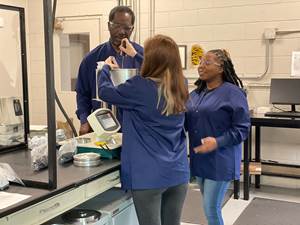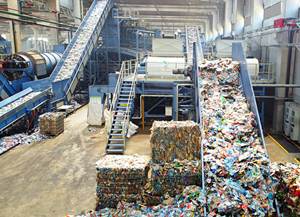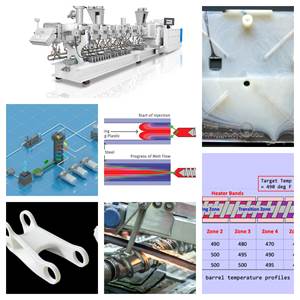Laser Marking Has a Bright Future in Plastics
Fast, programmable, environmentally clean laser marking has established a niche in basic marking of dates and product codes, but it is capable of much more. The market has barely touched the repertoire of decorative effects available with today's wider range of laser-markable resins, pigmentation technology, and laser equipment.
Decorating thermoplastics with laser marking has taken longer to gain acceptance than was expected a decade ago. Nonetheless, laser technology has been winning converts at the expense of ink marking technologies such as pad printing and inkjet printing in certain markets.
So-called "non-aesthetic" applications are estimated to account for some 90% of plastics laser marking today. Such markings, typically made with a sealed CO2 gas laser, include part numbers, date of manufacture, and expiration dates. Often the marks are dark letters and numbers on transparent or light-color backgrounds or off-white marks on dark backgrounds.
"Aesthetic" laser marking is the 10% of the market that has lots of potential for growth in replacing ink-based technologies. These are typically white markings on darker engineering resins, made with solid-state Nd:YAG lasers that are easily programmable and allow for very crisp marks in unlimited shapes.
Examples of successful commercial applications include ABS keyboards for business machines; HDPE, PP, PET, and PVC rigid containers and closures; nylon and PBT automotive and non-automotive electrical connectors; and underhood components such as fuse boxes and gas caps. Still others include TPE ear tags for swine and cattle, appliance parts like HDPE on/off knobs on washer/dryer units, and PVC plumbing parts such as elbows and fittings.
Emerging applications include light-switch covers, cosmetics packaging, toys, and auto-interior buttons and knobs on doors and instrument panels. The latter has become an important market focus in the last couple of years.
Technical advances in computer-programmable laser equipment over the last decade have been followed by development of more laser-markable grades of resins as well as custom colorant and additive packages for use with a variety of plastics from polyolefins and ABS to PVC, polyesters, PC, nylons, acetal, and TPEs.
Today's laser-markable plastics offer high contrast and, in many cases, a contrasting color rather than just black or white. Even degrees of shading are now possible. These more varied color effects are one of the concurrent trends that are bringing renewed interest in decorating plastics with lasers, according to marketing manager Patrick Schlather of Rofin-Baasel, Inc., a leading supplier of plastics laser-marking equipment.
Product traceability has become a major driving force behind this technology, notes Rick Stevenson, sales manager at Control Microsystems, another laser supplier. Product identity data and operating instructions that last throughout the product's life, often in more than one language, are ever more common requirements. Information on production history and specifications are particularly crucial for parts that have the highest liability in case they fail, such as electrical/electronic switch bodies.
Laser marking also satisfies the growing need to imprint greater amounts of data on ever-smaller plastic parts. For example, two-dimensional barcodes have been developed that have 10-times the data density of conventional barcodes. Marking these 2D codes requires more accurate and higher-resolution marking than had been adequate for previous barcodes. According to Schlather, laser marking meets these requirements with spot sizes and position repeatability in the range of 0.001 in.—performance that is difficult to match with pad or inkjet printers.
Environmental issues are another driving force. Laser marking uses no inks or solvents, nor does it require the energy-intensive drying steps typical of ink-marking technologies. For a three-shift marking operation, Schlather says ink and chemicals can cost $20,000 to $40,000 per year while printing plates can cost $100,000 per year or more, depending on complexity, durability, and marking changes. By contrast, a laser-marking system operating three shifts consumes less than $3000 in electricity annually. Other consumables, such as lamps and filters cost under $3500, according to Schlather.
Marking equipment basics
While there is a wide array of laser sources available for decorating plastics, the sealed CO2 gas laser is by far the most widely used, followed by lamp-pumped, solid-state Nd:YAG lasers, and the more recent diode-pumped Nd:YAG configuration.
Most of these laser-marking systems use high-speed, beam-steered galvonometer marking technology. The steering system sweeps the laser beam using two computer-controlled mirrors, or galvonometers, that move the beam in x and y directions. Explains Robin Barbero, marketing director of Preco Industries, "When the programmed laser path is completed, a new part indexes into position, and the cycle repeats. Since the marking pattern exists entirely in software, no tooling or masks are needed."
Software that allows marking of plastics with on-the-fly beam steering is also offered by several laser equipment suppliers. This is basically the same technique but applied to production situations with continuous motion such as conveyors or web converting, explains Barbero. "The advantage of such a system is that it can be easily retrofitted into existing production lines to maximize throughput. Encoder feedback is provided to the computer which makes appropriate adjustments to track the moving target in real time."
Adds Schlather from Rofin-Baasel, "Current systems use straightforward graphics-creation software that can be easily programmed to mark unique data on each and every part on the fly."
In recent years, programming, calibration, and troubleshooting of laser markers have become much easier, and marking speeds have increased greatly. Says Barbero, "Today's software allows marking of more than 400 characters per second, compared with 40 type-size, single-stroke characters/sec 10 years ago."
Most laser software has the capability for mark serialization, multiple types of barcode, and text of any type—including company logos. Using Windows-based "Help" functions, laser-marker suppliers have embedded service and calibration techniques along with troubleshooting software.
Another advance has been the development of systems that that can mark two parts simultaneously using one laser source. With the addition of another deflection head and a programmable beam splitter, a single laser can simultaneously mark two parts with the same information. Schlather points out this kind of system can also be used to mark a larger area without moving the part or tray of parts.
Recent developments include mergers of the two leading laser-marking equipment suppliers, Rofin-Baasel, Inc. (formerly A-B Lasers), which offers both CO2 and solid-state Nd:YAG systems, and GSI Lumonics (the product of an earlier merger of General Scanner Inc. and Lumonics). However, as of April GSI has exited the industrial laser-marking business.
Other players include Control Microsystems, which offers both CO2 and Nd:YAG laser systems; FOBA Laser Systems, which offers a broad range of Nd:YAG systems; and Preco Industries, which offers both CO2 and Nd:YAG turnkey systems.
Cost is a key factor behind the continued popularity of CO2 laser-marking systems. A complete turnkey CO2 system sells in the range of $25,000 to $35,000, whereas a lamp-pumped or diode-pumped turnkey Nd:YAG system typically runs $60,000 to $75,000.
A CO2 laser etches the plastic surface, removing material by evaporation. The result is a contrasting mark but little or no true color change. Plastics that mark well with CO2 lasers include PVC, ABS, and most polyesters. Commodity resins such as PP filled with mica produce a frosted pale-white mark using a CO2 laser. Although the power output of CO2 lasers can go up to 200 watts, the most popular range for marking plastics is 10-25 W and, in some cases, 50 W.
Where speed is the key, as in coding on bottling lines, or where large characters are needed, the CO2 laser is generally recommended. Steve Bone, president and CEO of FOBA North America Laser Systems, says CO2 lasers can apply dot-matrix markings about twice as fast as can Nd:YAG lasers, although the difference is only a fraction of a second.
Stevenson from Control Microsystems, whose main market focus has been automotive underhood and electrical/electronic parts, says that when evaluating a plastic-marking job, his firm first tries to mark it with a CO2 laser. "If we can't get the contrast needed or get excessive melting, we then go to one of the YAG laser systems."
Solid-state Nd:YAG lasers heat the plastic to cause a thermochemical reaction such as foaming and also produce more of a color change. These lasers give higher resolution due to their shorter wavelengths. The shorter the wavelength, the less heating is induced in the plastic substrate ("cold marking"). FOBA's Bone says that 100 W Nd:YAG units are currently popular for plastics marking because of their high throughput capability, but they are also available in a power output range of 30-50 W. YAG lasers are generally used for higher-quality marking on parts such as electronic connectors, underhood components, keycaps, and surgical equipment.
Rofin-Baasel's Schlather advises processors considering purchase of a solid-state laser to know what throughput is required and all the aesthetic requirements of the marking application. For example, if you want a high-contrast mark with no measurable surface disruption and shallow penetration into the material, a higher frequency (produced by so-called frequency tripling or quadrupling) may work best. That depends, however, on whether the low output power of this style of laser meets your throughput objectives.
There are also the newer diode-pumped YAG lasers with power ranges of 3 to 100 W, which replace the lamps in lamp-pumped units with a diode array as the laser light source. Diode versions are said to be about 50% more compact, and 20% to 30% more energy efficient. Lamp systems require water cooling, while diode types use water or air cooling. And while lamps generally need replacement every 1000 hr, the diode has a life span of 10,000 hr. The disadvantage is that diode types are still relatively new and more expensive. For example, FOBA's 50 W diode-pumped laser system costs 10% more than its 100 W lamp system. But FOBA's Bone projects that diode-pumped system prices will drop in the next few months and that they may eventually replace lamp-pumped units altogether.
Schlather from Rofin-Baasel sums up the choice of YAG laser types: "If scheduled maintenance every 600 to 800 hr is acceptable to you, the lamp-pumped systems yield the highest throughput for the least amount of investment. But if you can achieve the desired mark with a 3 to 60 W diode-pumped unit, then over a five-year period the cost of ownership will be less than for a comparable lamp-pumped unit." He notes that this advice is based partly on the projected volume increase in diode-pumped unit sales bringing down the cost of replacement diode stacks.
Formulating for lasers
Bone from FOBA says almost any plastic can be marked by any type of laser if formulated with the right selection of additives. The formulator or masterbatch supplier needs to know about the resin, end-use application, and type of graphics required. For example, certain plastics such as HDPE and polycarbonate mark very well in some colors using YAG lasers without help from any special additives. On the other hand, CO2 lasers may not do very well in marking these two plastics without special additives.
Among the current limitations of the technology are restricted ability to obtain a color-matched laser mark and the cost of laser-optimized plastics, which typically sell at a 10-15% premium and sometimes more.
Bill Blasius, director of technology at Clariant Corp.'s Masterbatches Div., concedes that laser marking has also been limited in its color choices and color brilliance. He says, "We have greater knowledge than 10 years ago as to how to use pigments and additives. We look to how we can best take advantage of the chemical reactions that occur between a particular resin and certain additives and pigments when laser light is applied."
Thanks to advances in compounding technology, one can now get nearly white marks on black or dark-blue acetal copolymer, and off-white laser marks on dark ABS. Using specific color formulations and laser parameters, one can even achieve matched colors. Explains Schlather, "In this way, laser-etched marks can be matched to Pantone, Munsell, or other industry standards. The pigment in the resin determines the chroma or hue, while the laser settings determine the intensity or shade."
Many laser-marking color/additive formulations have been based on surface-treated mica pigments, such as the popular Afflair and Laser Flair lines made by EM Industries. But other additives, such clay or talc and inorganic salts of copper and antimony, are also used in these proprietary formulations.
Pioneers in laser-markable plastics include BASF, Bayer, Ticona, and RTP Co. Leading suppliers of custom color and additive masterbatches for laser marking are Clariant and PolyOne.
Focusing first on automotive applications, Ticona began with the introduction of two laser-markable black acetal grades, Celcon LM90 and LM90Z. LM90 is for marking underhood and fuel-system components and LM90Z is a uv-stabilized version for interior parts such as speaker grilles and release levers. Automotive market manager Tom Miller says the proprietary additive package responds best to Nd:YAG lasers.
Ticona's newest development is Celcon UV140LG, which is said to be the first low-gloss laser-markable acetal copolymer. It also features UV resistance. It appears in buttons for radios, hazard lights, and cruise controls in some 2001 and 2002 model-year cars.
Ticona is also now offering laser-markable neat, glass-filled, and mineral/glass-filled grades of Celanex PBT for non-cosmetic marking of automotive electrical/electronic components. Laser-markable Vandar PBT-based blends and alloys are aimed at airbag internal components. New laser-markable Celanese nylon 66 grades are also under evaluation for auto-interior components.
According to Ticona's Miller, most automotive applications involve black substrates with marks in off-white to white. "Not only does the particular black shade have to match each OEM's specs, but so does the white. The degree of white obtained will typically depend on the additive package."
Laser etching, or more accurately, paint engraving, has been used since the mid-1980s for day/night backlit components such as faceplates, and switches or knobs on car stereos, environmental controls, and mirror housings. Such components are typically clear polycarbonate or ABS that is first painted white and then overpainted in black. The laser is used to etch through the black, so the white shows through when the part is backlit. Says Ticona's Miller, "Laser-markable plastics, in conjunction with creative part design and fabrication technology such as two-component molding, has potential for eliminating these secondary operations."
RTP is now offering several neat and reinforced laser-markable compounds of PP, nylons (6, 66, 12, 11, and 612), ABS, LLDPE, acetal, polysulfone, PBT, syndiotactic PS, TPU, TPO, PPS, acrylic, PC/acrylic, PC/ABS, and LCP. Says color-business manager Stuart Swain, "There are tremendous opportunities for different colors to be marked white, green, or yellow on a black background."
Research at BASF's laser-marking laboratory in Germany has shown that addition of glass fibers reduces the markability of plastics only slightly, but some fillers, flame retardants, and even regrind can greatly reduce markability.
BASF's laser-markable offerings include dark colors of Terluran ABS, Ultraform acetal, Luran S ASA, Ultramid nylon, Luran SAN, and Ultradur PBT.
Similar work has been done by Bayer in Germany, which offers laser-markable grades of polycarbonate, ABS, and PBT.
Most of Clariant's laser-marking masterbatches are customized. "We have our base pellet for laser marking—either a mica-based or a proprietary additive formulation that we build on to create the custom masterbatch." Current color effects Clariant can achieve are primarily gradients from white to gray to black on any color substrate. On very dark substrates, Clariant can provide a blue, red, or green mark. Blasius expects that a broader range of colors will be achieved in the next few years.
David Bates, market manager for FastMark laser-markable additive concentrates at PolyOne Corp., says his firm's newer concentrates allow for much higher contrast of pure black marks on a white substrate and pure white marks on a black substrate. PolyOne also offers concentrates that can provide virtually any color of marking—usually on black parts. The firm can combine its various special-effects colorants with a laser-markable additive to provide widerpossibilities—such as a glitter mark on a natural colored PE container. These new options appear to be gaining considerable interest in high-end SAN cosmetic packaging and polyolefin shampoo and conditioner bottles and closures, as well as toys. PolyOne has formulated FastMark additives for both neat and glass- or mineral-filled grades of polyolefins, polycarbonate, PC/ABS, and SAN.
Several other firms have supplied laser-markable formulations on a low-key basis. Among them are Ferro Corp., A. Schulman, and LNP Engineering Plastics. Schulman makes laser-markable compounds and PolyBatch concentrates for ABS and polyolefins used in auto interiors. LNP offers laser-markable versions of its StarFlam flame-retardant nylon compounds for electrical parts, as well as some Stat-Kon formulations of polyphenylsulfone for medical trays and ABS, PC, and acetal for surgical instruments.
Related Content
SD Polymers: 'One-Stop Solution for Mechanical Recycling'
‘Passionate’ recycler invests in people and technology to meet commitment to innovative, sustainable solutions for its processor customers.
Read MoreAutomation in Thermoforming on the Rise
Equipment suppliers’ latest innovations exemplify this trend driven by factors such as labor shortages, higher-speed thermoformers and tighter quality control.
Read MoreHot Wash Systems for Recycling Polyolefins
Herbold can configure wash plants for polyolefins that can produce high-quality, food-grade recyclates.
Read MorePlastics Technology’s Most-Viewed Articles from 2022
Tips, new technologies, resin pricing, best practices and more piqued reader interest at Plastics Technology in 2022.
Read MoreRead Next
Processor Turns to AI to Help Keep Machines Humming
At captive processor McConkey, a new generation of artificial intelligence models, highlighted by ChatGPT, is helping it wade through the shortage of skilled labor and keep its production lines churning out good parts.
Read MoreLead the Conversation, Change the Conversation
Coverage of single-use plastics can be both misleading and demoralizing. Here are 10 tips for changing the perception of the plastics industry at your company and in your community.
Read MoreWhy (and What) You Need to Dry
Other than polyolefins, almost every other polymer exhibits some level of polarity and therefore can absorb a certain amount of moisture from the atmosphere. Here’s a look at some of these materials, and what needs to be done to dry them.
Read More






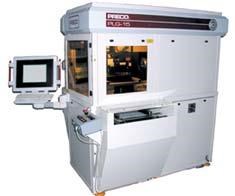
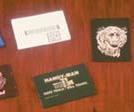

















.png;maxWidth=300;quality=90)


